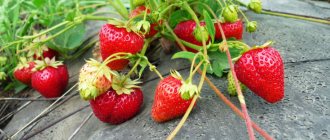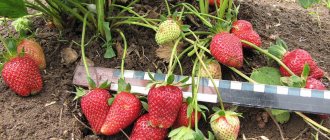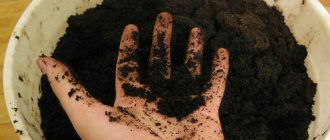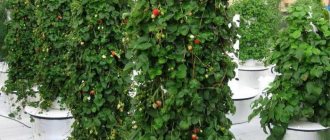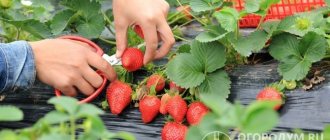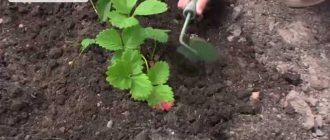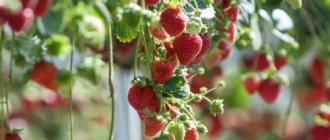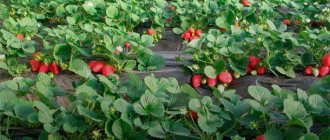Strawberries are one of the most popular berries. That is why it is grown in the country, in the garden. I especially want to enjoy the berry in winter. You can buy it in the supermarket, however, self-grown strawberries have excellent taste and do not contain nitrates. The berry has some characteristics that must be observed when growing.
Pros and cons of greenhouse growing
The main advantage is that it is possible to harvest your favorite berries throughout the year. Thus, the gardener will have strawberries all year round, and they can not only be enjoyed, but also sold. In winter, she uses a lot of millet, and the prices are several times higher. There is an opportunity to make good money selling berries.
Weather conditions do not affect the yield of strawberries in the greenhouse, because they are in optimal conditions for normal growth and development. If it grows in open ground, the crop yield is reduced by 25%, in contrast to growing in a greenhouse.
Another plus is saving space on the site. In addition, caring for berries is much easier when they grow in a greenhouse. Homemade strawberries do not contain harmful substances to human health, unlike the dubious berries sold in supermarkets. It’s better not to take risks, but to grow tasty and healthy strawberries yourself.
The only drawback to obtaining berries this way is the cost. To get a good harvest, you will need to increase daylight hours using additional lighting. The crop also requires artificial pollination.
Recommended primer
Regardless of whether the gardener has chosen the best variety of remontant strawberries or settled on a new one, it is worth taking care of the PH of the soil. The soil should not be acidic or alkaline. The best option for good growth and fruiting is slightly acidic or neutral soil. To check the PH level, you can take a sample of soil to the laboratory or conduct a comparative analysis at home using test strips and soil diluted to a liquid slurry with settled water.
If you believe the reviews left by summer residents on many city forums, we can conclude that the most optimal areas for planting are wetlands, areas located in areas of groundwater and black soil.
To prevent strawberry roots from rotting and the berries to gain the required weight, you should periodically loosen the soil. At the time of fruiting and flowering, it is better to replace this process with mulching.
Types of greenhouses
Greenhouse structures are divided into several types:
- wooden structure with polyethylene film;
- aluminum structure covered with polycarbonate sheets;
- metal structure with glass.
The most common type is a wooden frame covered with a thick film. Its widespread use is due to several positive aspects, including: the simplicity of the device and the low cost of the necessary materials. The disadvantage is that this method is not suitable for growing berries all year round in a greenhouse. A film greenhouse will be an ideal solution from March until October.
A polycarbonate greenhouse is the best option for these purposes. It is durable and reliable. Perfectly retains heat and moisture, perfectly transmits sunlight. This type of greenhouse has an affordable price.
A metal frame with glass ceilings is considered the most expensive of those listed. The greenhouse maintains the necessary microclimate and warms up quickly enough. Heat loss from a metal greenhouse with glass ceilings is minimal.
What should you consider when building a greenhouse?
When working, adhere to the following algorithm:
- It is necessary to select the material to create a greenhouse and construct it.
- Create a microclimate using heaters and possibly humidifiers.
- Purchase gardening tools and set up an irrigation system.
- Fill the greenhouse with soil suitable for garden strawberries.
- Buy preparations for treating diseases and pests, fertilizers.
- Select planting material.
At first glance it seems that everything is very simple, but this is not at all the case. When choosing equipment and materials for construction, many factors must be taken into account; you should also carefully consider the choice of strawberry variety for planting.
Choosing material for the greenhouse
The main requirement for materials used for the construction of greenhouses is increased insulating properties. They must be durable and adapt to the weather conditions in the region.
The following factors are taken into account:
- the lowest temperature in the region in winter;
- wind force;
- amount of precipitation in centimeters.
Three materials are used for artificial structures:
- The cheapest is film. The disadvantage is unreliability. Such a greenhouse will not work fully in winter; the film quickly deteriorates, tears and becomes cloudy, so its service life is several years. Not suitable for northern regions because it does not provide enough protection from the cold. The method is not applicable for year-round cultivation.
- Glass is an expensive option for constructing a greenhouse, but in comparison with film, such structures are considered quite reliable. They require a foundation; the glass itself is mounted in special frames. Keep in mind that you cannot save money and buy thin glass, because it will be very fragile and can be destroyed by hail or break under the weight of snow. Maintaining a microclimate is simple, but you need to use a ventilation system, control the temperature and arrange heating.
- Polycarbonate is the golden mean. It is considered the best material for constructing a greenhouse. It is cheaper and stronger than glass, and can withstand heavy loads if the frame is made of metal. Service life - more than 15 years.
Attention! Each material has its own advantages and disadvantages. Remember that the greenhouse is being built with the prospect of service for decades. During this time it should fully pay off.
Necessary equipment
The estimate compiled for organizing a greenhouse for strawberries includes the cost of additional equipment.
Need to buy:
- drip irrigation system;
- lighting fixtures and lamps that save energy;
- electric or gas boilers;
- fans;
- thermometers;
- containers for planting crops;
- racks for organizing vertical growing.
Preparing containers
They grow dugouts in a greenhouse directly on the beds. To save space, you can plant the berries in containers that are placed on shelves. Thus, there are several tiers with containers. To ensure normal development and fruiting, bushes require lighting. To ensure there is enough light for everyone, the distance between the tiers is maintained at least 50 cm. Some gardeners hang pots for this purpose.
Cereals are considered the best predecessors. That is why it is recommended to install the greenhouse in the place where they grew. You can take soil from the garden and deliver it to the greenhouse. In this case, it is not recommended to use the soil on which tomatoes, potatoes and peppers were grown. Soil preparation
To obtain a rich harvest, special soil is used. To prepare it, you need to mix chopped straw with chicken manure, gypsum, chalk and urea. The process looks like this:
- Chicken manure and straw are laid out in layers in the container.
- The contents of the container are poured with warm water and left for a month.
- During this time, the fermented mixture is stirred twice.
Chalk, gypsum, and urea are added to the resulting dark brown mixture. The resulting substrate is rich in calcium, nitrogen and phosphates. Thus, the crop will grow well and will not require a large amount of fertilizing.- The last stage is warming up. It is necessary to sterilize the substrate.
It is important to monitor the temperature; it should not exceed 60 °C. Otherwise, it will overheat and lose its beneficial qualities.
How to get an early strawberry harvest, algorithm
To get strawberries in March-early April, young strong bushes are planted in 0.7-1 liter pots with a good drainage layer. Let it take root. After rooting, around September, they begin to shade by covering with cardboard one and a half to two hours before dark. And open it in the morning. Watering is moderate, without overflowing, but also without allowing the earthen clod to dry out.
Strawberries at home: organizing a dormant period
With the onset of frosty weather, pots of strawberries are brought into the cellar or a dark, but not frozen room. During this period, the plants are not watered. Desired temperature +3...+8 degrees.
Growing strawberries at home: growing season
As a rule, at the end of January, strawberries are prepared for moving to the window. First, they are transferred from the basement to a closed veranda or loggia with a cool temperature. You can keep them on the floor for several days, where it is cooler. When the earthen ball warms up a little, the plants are moved to the windowsills of the southern or south-eastern windows.
The optimal temperature for growing vitamin berries is +18…+24 degrees.
Light mode
To get a harvest of juicy berries, you need to organize lighting for strawberries. First, extend the daylight hours, including lighting 2 hours before dawn. In the evening, extend the day by 2-3 hours after sunset. Secondly, the backlight must provide a sufficient level of illumination during the day. Because in winter, cloudy days are not uncommon, and the plants will not receive the required amount of light.
For illumination, it is better to use a fluorescent or phytolamp, placing it at a height of 25-30 cm above the plants.
How to care for berries in a greenhouse
(adsbygoogle = window.adsbygoogle || []).push({});
To get a rich harvest of tasty berries, it is important to maintain all the conditions necessary for growth and development. Strawberries require timely watering, special temperature conditions, good lighting and fertilizing.
Watering mode
Water the berries in different ways. The following methods are used: drip irrigation, sprinkling. To grow a rich harvest of strawberries, before they bloom, water only by sprinkling. After this, the greenhouse berries must be watered at the root between the rows so that water does not get on the flowers and leaves. This measure is necessary in order not to knock the flowers off the plant with the flow.
Strawberries are watered approximately once every 8-10 days. When the fruiting period begins, it is necessary to water as needed. You also need to pay attention to weather conditions. It is recommended to water the bushes in the early morning, about once or twice a week. You cannot flood the bushes. This will lead to fungal diseases occurring. After watering, it is necessary to carefully loosen the soil so as not to damage the roots. Thus, they are saturated with oxygen, which helps to increase the yield.
Lighting
When growing berries in a greenhouse in winter, additional lighting is required, since the sun's rays do not pass through the coating well. In addition, daylight hours are not enough to obtain a good harvest. To do this, additional light sources are installed in the greenhouse. In autumn and winter, daylight hours should be at least 13-15 hours.
The optimal light source option is high-pressure sodium lamps. For 3 square meters of greenhouse you will need one lamp with a power of at least 400 W. If the crop is illuminated for more than 13-14 hours a day, the yield will increase.
Optimal temperature and humidity
To successfully obtain a strawberry harvest, a certain air humidity and temperature conditions are required. To do this, purchase equipment. From January the optimal temperature is + 10 +12 °C. As daylight hours increase, it must be increased to + 20 °C. At night the temperature is maintained at about +8 °C. When the plants begin to bloom, increase to + 25 °C. However, it cannot be increased sharply. Otherwise, the plant may not withstand sudden warming.
As for air humidity, during the planting period and for several more weeks it is 85%. Only after this the level is reduced to 80%. Reduce the humidity again when the plant blooms.
Fertilizers
Like all plants, strawberries need fertilizer. They are applied in liquid form once every 7 days. Be sure to water the plants before fertilizing. This will protect the roots from getting burned. Ammonium nitrate, superphosphate, and potassium salt are used as fertilizers. Sometimes chicken manure is used. Plants are fed only until ovaries form.
To avoid the occurrence of various diseases, you must adhere to the following actions:
- Plant plants at the optimal distance from each other.
- Stick to a watering schedule.
- Always check the ground. It should not be over-moistened.
- Remove weeds in a timely manner.
Choose the right fertilizers and use them on time.- Monitor the condition of the plant and, if necessary, use pest control products.
Rules and boarding process
Before growing strawberries in a pot, you need to choose a variety, prepare containers and substrate, choose a location, and think about lighting.
Selection of container and substrate
The soil for growing strawberries should be:
- nutritious;
- loose;
- slightly acidic;
- permeable to water and air;
- have a stable structure.
Sometimes you can find a special substrate for strawberries on sale. It is produced by the following brands:
- Fusco;
- Veltorf;
- Seliger-Agro.
The substrate for strawberries can be taken as a universal one, improved by adding coarse sand or perlite, or fully prepared humus. Or make your own by mixing equal parts:
- turf land;
- sand;
- humus.
If there is a problem with the first component, it is replaced with neutral peat. The components of the substrate should be calcined in the oven or steamed. When disinfecting with potassium permanganate, exceeding the concentration will lead to the death of the strawberry bush.
It is not recommended to take garden soil - it contains pathogenic microorganisms and soil pests that are difficult to destroy.
Strawberries can be planted in hanging flowerpots, pots or long plastic boxes 20-25 cm high. When choosing a container, you should take into account that each bush will require 3 liters of substrate, unless the variety description says that strawberries can grow in a smaller volume of soil.
The best material for a pot is plastic. It is easy to make additional holes in the bottom with a soldering iron or a hot nail - when growing strawberries at home on a windowsill, good water drainage is important.
Drainage in the pot is required. Use expanded clay or broken red brick; if possible, put pieces of drainage coal on the bottom, this will protect the garden strawberry bushes from rotting of the root system.
For growing, you can also use improvised materials, ceramic pots or special structures.
Preparation and planting of seedlings
The answer to the question whether it is possible to grow day-neutral strawberries dug up in the garden and transplanted into a pot in winter is positive. It is not necessary to buy planting material if there are suitable varieties of strawberries in the garden.
You can take a young bush or a well-rooted daughter rosette and move it into a pot. For winter fruiting, the operation is carried out in August, in the south - no later than mid-September.
- Dig up garden strawberries from the garden bed.
- Trim leaves affected by diseases or pests. If there are many of them, leave 2 to 4 of the youngest.
- Remove all berries and flower stalks. Without them, the strawberries will take root better and faster in the pot.
- Wash and treat the root with a fungicide. Before planting strawberries, it needs to be shortened to 8-10 cm.
- Pour drainage and substrate into the pot and form a mound on the surface.
- Place a strawberry bush in the center, spread the roots around the hill - they should not bend.
- You need to add soil gradually, constantly compacting it. The growth point should be at the level of the substrate surface; the heart should not be buried or protruded.
- Water the strawberry bushes generously with a solution of root or heteroauxin so that the water flows out of the pot into the tray.
- After 20 minutes, drain off excess liquid.
- If the soil has settled, add more substrate.
- Place the pot in a cool, shaded place for 2 weeks.
When planting strawberry bushes obtained from nurseries or stores in a transport container, it is enough to place in a pot of the required size:
- lay drainage;
- move the earthen lump;
- add substrate;
- water.
If strawberries are going to be grown in long containers rather than pots, the distance between the bushes should be at least 20 cm.
Seedlings from seeds
In winter, you can get a harvest of strawberries on the windowsill by planting seeds in the spring. First you need to harden them - spread the strawberry seeds on a clean, damp cloth, fold them in half, and place them in a bag. Keep in the refrigerator for a month. Then you can sow:
- Pour soil for seedlings into a low, wide box.
- Lightly compact, level, and moisten the surface with a household spray bottle.
- Arrange the strawberry seeds in a 2 x 2 cm pattern.
- Sprinkle with a thin layer of substrate.
- Cover with glass or transparent film.
- Place in a warm, bright place.
- Ventilate daily and check soil moisture.
- After the emergence of seedlings, gradually accustom the strawberry seedlings to fresh air and place them on the windowsill.
- At the stage of 2-3 true leaves, plant strawberries into individual cups or seedling trays.
- When the strawberry bush has mastered small containers, transplant it into permanent pots.
Growing strawberries from seeds is not easy. For beginners, seedlings may not germinate well and often die when planted in pots.
Strawberry varieties for greenhouses grown all year round
Growing berries throughout the year requires certain knowledge. Before doing this, in the absence of experience, you need to familiarize yourself with the intricacies of the crop and the features of its cultivation. Which varieties are suitable for growing all year round?
Thus, it will be easier to decide which variety of strawberries is more suitable for obtaining a large harvest throughout the year.
The following varieties are considered popular:
- Crown;
- Sonata;
- Elsanta;
- Khoniei.
Did you know! Some varieties of berries require pollination. To do this, each bush is treated with a brush. Experienced gardeners also install hives with bees in the greenhouse where strawberries grow. Bees help pollinate plants.
Monterey
Powerful plants grow intensively, require sufficient space for planting and produce up to 14 flower stalks. They produce large cone-shaped berries of a dark red hue.
They are sweet and dense, good for sale on the market. Freezing does not affect the shape and consistency of the fruit. Each weighs on average from 30 to 40 grams. The yield per plant exceeds 500 g.
Flowering begins in early May and continues until frost. Monterey, when properly cared for, produces 4 waves of harvest throughout the season. The second shows the most delicious strawberries.
Forms a moderate number of tendrils, which helps avoid thickening of the beds. The advantage of the variety is resistance to diseases: on the eve of winter it requires shelter.
Remontant varieties of strawberries
When growing in a greenhouse, it is recommended to use remontant strawberry varieties. They do not require pollination. Another positive quality is that the berry bears fruit several times a year. Among the remontant varieties, the most popular are:
- Albion;
- Queen Elizabeth;
- Temptation F1;
- Lyubava.
The Albion variety of berries is high-yielding, the berries are tasty and aromatic. A distinctive feature is that the variety does not form a mustache. Strawberries bear fruit early and abundantly.
The popular variety Queen Elizabeth differs in the size of its berries. Some of them reach sizes of 125 g. Up to 5 kg of berries are collected from one bush. The berries are incredibly beautiful, dense and red. The berry needs regular renewal.
The Temptation F1 variety allows you to grow berries with a unique taste and aroma. The berries are dense and juicy. They reach a size of 40 g. Fruiting is early - the harvest is harvested within a month and a half after planting. Each bush produces one and a half kilograms of berries.
Strawberries Lyubava are very aromatic and tasty, but not large. It is distinguished by its high yield, reaching two kilograms per bush. The plants take root immediately and begin to bear fruit very early.
What soil is needed for year-round growing of berries?
Particular attention should be paid to the soil. It is its quality that will determine how quickly the next wave of harvest is formed. To do this, you need to remember just a few rules for creating soil. Let's take a closer look at them.
- There must be drainage . Regardless of where you grow it, it is necessary that moisture entering the soil quickly passes through the root system and does not linger in it. In this case, oxygen will better flow to the roots, and the plant itself will develop faster. This will also keep the soil loose, which is important when growing berry crops. To prepare the drainage, we need crushed stone or gravel, which must be placed at the very bottom of the pot, box, bed or bag. As a rule, it occupies no more than 25% of the volume of the entire soil.
- Mix fertile soil with sand. At least 25% should be sand so that the soil is very loose. This will increase the gas exchange of the root system, as a result - the bushes will grow much faster and form new berries. It is best to use coarse sand, which is mixed with soil and poured immediately onto drainage crushed stone or gravel.
- The soil should contain peat, organic fertilizer and other useful substances that will help the plant start and quickly move into the stage of formation of generative organs. If the soil is of poor quality, the bushes will be “dwarf” for a month and may not grow at all to the size we need. The number and size of fruits will also be affected.
- High quality fertilizer. Without it, nothing will grow - this is clear even to a beginner. If you grow remontant varieties, you need to double the dose of fertilizers, since these varieties pull every last gram out of the soil and after them the soil becomes deserted. Constant addition of nitrogen and ammonia fertilizers should be your rule. When planting bushes, you need to add a lot of organic components, as well as nitrogen, so that the root system takes root as quickly as possible and begins to release useful substances to the stem. Immediately after the plant takes root in a new place, you need to add superphosphate and ammonium nitrate - they will help gain vegetative mass and grow the bush to its maximum size. Then feed with orthophosphorus fertilizers - they will help increase the size of the fruits and collect a maximum of one bush.
If you do everything correctly, and the soil is not only perfectly composed, but also saturated with minerals and macroelements, then you can count on a solid harvest and high quality berries!
Ways to grow strawberries
There are several ways to get a strawberry harvest in a greenhouse all year round. They differ depending on where the berries are grown in the greenhouse. Strawberries are planted in beds and containers. Not long ago, another method appeared - the Dutch growing technology.
Growing method in soil
For planting in the ground, tendrils of 1st and 2nd order are used. Seedlings are purchased at the store. There is also the opportunity to grow it yourself. First you need to prepare the beds. The optimal width is about 100 cm. They are usually located from north to south. This method of arrangement will provide the bushes with the maximum amount of heat and light.
At the bottom of the beds it is necessary to pour fine crushed stone in a layer of 6 cm. You will also need sand in a layer of 10 cm and black soil - 10 cm. The holes are dug 10 cm deep, it is recommended to place them in a checkerboard pattern. In order for the bushes to grow strong and healthy, fertilizers are poured into each hole.
The seedlings are carefully placed in the holes and buried in soil. You definitely need to pay attention to the location of the outlet; it should be located at ground level. Under no circumstances should it be buried in the soil. Also, you should not plant it high above ground level.
Technology
In order to master the technology of year-round cultivation of strawberries in a greenhouse, it is necessary to select the variety needed for this purpose and test it.
Variety selection
And here you need to pay attention to remontant, self-pollinating varieties of day-neutral strawberries, and with early ripening periods. The choice in favor of early varieties of such strawberries is determined not by the early stages of ripening and formation of the berries, but by the technology and agricultural technology of their cultivation.
The fact is that it is the early varieties of strawberries that, when planted thickly, give the maximum yield. That is, on one m² of usable area of the bed, up to 100 bushes of remontant strawberries can grow, and such thickened planting does not reduce the yield at all, but only, on the contrary, increases it.
The second reason why you should choose these varieties of strawberries is the light regime. It is no secret that the entire vegetative growth period of any plant is based on the length of daylight hours. So, the term “neutral day” means that such strawberries do not react at all to the light regime during the process of flowering and berry formation. A clear example: late varieties of strawberries begin to form ovaries in short daylight hours, medium varieties, on the contrary, in long daylight hours, but day-neutral strawberries produce a stable harvest under a fixed light regime.
The third thing you should pay attention to when choosing a variety is the continuous process of formation of inflorescences, ovaries and berries. That is, all these processes during year-round cultivation of strawberries must occur continuously. Otherwise, after each harvest wave, you will have to wait a long time (1 month or more) for the next wave. Therefore, when buying recommended strawberry varieties, you need to test them during one summer season. Simply put, purchase the maximum number of strawberry varieties, preferably seeds, and choose the most suitable one.
Preparing the beds
In fact, the technology for growing strawberries in a greenhouse is quite simple, and there is no wisdom or know-how here, since, again, everything is based on two principles: lighting and nutrition.
In order to more rationally use the greenhouse space, as well as provide the necessary amount of nutrition to strawberry bushes, it is better to grow them not on the ground, but in hanging containers. Therefore, first let’s look at their design.
Container base
It is better to make the bases for containers entirely welded from a metal profile, as they will experience heavy loads. The optimal width of the base is 1 m, the length is limited only by the length of the greenhouse. Next, the frame for the containers needs to be divided into several sections for two rows of containers: on the left and right sides at a distance of 20 cm from the edge, we weld a metal corner along the entire length of the frame and subsequently install cone-shaped containers in these spaces.
That is, you should get a kind of metal flat frame, on a rigid base, 1 m wide, of arbitrary length, with two longitudinal sections, 20 cm wide, located along the edges of the frame.
Containers for bushes
Any available material is suitable for making containers: plywood, fiberboard, plastic, cellular polycarbonate, etc. It is better if the container is solid along the entire length of the frame. Container dimensions: length - arbitrary, height 20-25 cm, width at the bottom - 15 cm, width at the top 25 cm. And when the required number of containers is made, we simply insert them into a metal frame and fill them with substrate.
Substrate preparation
As you understand, intensive and continuous fruiting of strawberries requires the creation of a highly nutritious environment. Therefore, the usual soil in which strawberries are grown in summer is not suitable here. For these purposes, you will have to make a highly nutritious substrate.
Components for preparing one ton of substrate:
- Oat or winter wheat straw – 650 kg.
- Chicken droppings – 300 kg.
- Chalk – 6 kg.
- Urea – 3 kg.
- Plaster – 20 kg.
As you can see, the components described above are quite common, straw can be obtained from the fields after harvesting grain crops, and chicken manure can be obtained from any of the poultry farms, of which there are plenty in each region. However, in order to obtain a high-quality substrate, you need to properly compost all components.
Substrate composting
For this purpose, all components are laid layer by layer in a pile in the following order:
- The first layer is straw 20-25 cm high.
- The second layer is chicken droppings 10 cm high.
- Third layer - urea: 400 g. per 100 kg of straw.
Thus, a pile 1-1.5 m wide and 1.8-2 meters high is formed layer by layer. At the same time, during the formation of the pile, each layer must be thoroughly shed with water, preferably warm. In about 5-6 days, the fermentation process of the components will begin, which will last about a month. And in order for all components of the substrate to ferment evenly, it is necessary to carry out the so-called interruption, i.e. mixing of the compost heap. The first interruption is carried out 10-12 days after the start of fermentation, the second - after 17 days and the third - after 25 days.
To do this, dismantle the entire compost heap and try to fold its edges into the middle, and, on the contrary, move the middle to the edges, adding chalk and gypsum to it at equal time intervals. When the composting process of the substrate is completed, it should have a uniform structure, dark brown color and no ammonia odor.
However, the procedure for preparing the substrate for strawberries does not end there, because it still needs to be sterilized. And this moment must be taken very seriously, since all kinds of aphids, mites, viruses, etc. can completely destroy the entire strawberry plantation.
Sterilize the substrate as follows:
Take a metal tray of any size, pour the substrate into it, cover it with a lid and raise the temperature of the compost over low heat to 55-60 degrees Celsius. The compost must be kept in this state for 12 hours, and most importantly, it must not be overheated, otherwise it will become “dead soil” on which nothing will grow.
Drip irrigation system
Before pouring the substrate into containers, they need to be equipped with a drip irrigation system for strawberries, and also adjust the water flow at the rate of: 1 m of container length - 3 liters. water per day. To do this, you will need a container of the required volume, which is installed 0.5 m above the level of the strawberry beds, and hoses.
Hoses, or more precisely, one long hose, are attached to the container and pulled along the bottom of the containers, making a plug at its end. Just first pour a layer of substrate 10-12 cm high into the containers, and make thin holes in the hose itself after 2-3 cm, through which the strawberries will be watered.
Adjusting the drip irrigation system
Adjusting such an irrigation system is quite simple. To do this, multiply the total length of all containers by the flow rate - 3 liters. water per day and by increasing the number of holes in the hose we regulate the water supply, as well as its total average daily volume.
In addition to its direct purpose, such an irrigation system serves as a kind of channel for supplying plants with nutrient solutions. Surely you have heard or seen in stores all kinds of strawberry fruiting growth enhancers, etc. So, they can be successfully used for year-round cultivation of strawberries with only one caveat - carefully follow the instructions on the packaging of the solutions, buy them only from trusted manufacturers and use them in in accordance with the vegetative period of plant growth, as well as taking into account the characteristics of a particular strawberry variety.
Growing in bags, or Dutch technology
This method is considered quite new. It allows you to get a large harvest of strawberries every 2 months. Remontant varieties are used. The berries are planted in plastic bags. They are placed horizontally or vertically in the greenhouse. The room must be provided with good ventilation. The fact is that when growing berries in a greenhouse, a sufficiently high temperature and high humidity can cause the soil in the bags to rot.
The berry bushes are placed in bags. The distance between them should be about 20 cm. This is done in order to provide each bush with the necessary amount of light. Plastic bottles are often used for watering. Their volume is at least 2 liters. A bottle of water is placed above each bag. Several holes are made in the lid and droppers are inserted into them. From two to five pieces is enough. The ends of the droppers are placed to the roots. Such an irrigation system assumes a water consumption of 2 liters per bag of berries per day.
Did you know! For better illumination of each bush, special reflectors are installed in the greenhouse.
Growing strawberries requires effort, but with the right approach you can get a rich harvest. In addition, in winter the berry is in demand and you can earn extra money by selling it.
Growing strawberries in a greenhouse all year round
Related Materials:
Strawberries all year round: features of growing and caring for berries in a greenhouse
Growing strawberries in greenhouse conditions in winter: how to do it correctly, basic methods and recommendations
Another secret to a rich strawberry harvest: organizing a greenhouse
Greenhouse growing of strawberries vertically
Diseases and pests
Sometimes the experience of growing strawberries on a windowsill can be unsuccessful. Plants are damaged by pests and suffer from diseases. In most cases, with timely treatments, they can be saved.
Blackleg
Affects strawberries at the seedling stage. Outwardly healthy plants begin to die suddenly at some point. The spread of blackleg begins in conditions of high humidity and low temperature. In most cases, it looks like this: the seedlings were watered abundantly and placed on a cold windowsill. To save the plants, the container is moved to a warm, well-lit place and treated with fungicides. You can use Bordeaux mixture.
Root rot
The main reason for the development of root rot is flooding with water. The problem occurs with excessive watering, lack of drainage, or constant stagnation of moisture in the pan. To save diseased plants, they are urgently transplanted into fresh soil. For the first 2-3 days, the bushes are not watered, only the leaves are sprayed. It will most likely not be possible to save severely damaged plants, but partially damaged plants will begin to grow in 1-2 weeks.
Gray rot
The disease affects the fruits. Gray rot is a frequent companion of thickened plantings. Its development requires high humidity and heat. Infected berries become abundantly covered with a characteristic gray coating and then die. With severe progression, leaves and stems may suffer from gray rot. To combat the disease, fungicidal drugs are used:
- Horus,
- Bordeaux mixture.
To prevent the disease, it is necessary to adjust the conditions of detention.
Aphid
Strawberry plantings often suffer from aphid infestations. Colonies of this sucking pest abundantly cover the lower part of the leaves. Damaged leaf plates curl and dry. To kill aphids, you can use regular laundry soap. All parts of the plant are treated with its solution. If the number of pests is too large, insecticides are used:
- Commander,
- Tanrek,
- Aktara.
In most cases, one treatment is sufficient to kill aphids.
Spider mite
A dangerous pest that feeds on plant sap. Due to its very small size, it can only be detected after mass distribution. A characteristic sticky coating in the form of a cobweb appears on the leaves, and after a while the infected plants begin to dry out. Insecticides are not used to kill spider mites. Due to their biological characteristics, they are simply ineffective. When fighting, acaricides are used:
- Aktellik,
- Fitoverm.
Every year, more and more varieties of strawberries appear, suitable for growing at home, characterized by tasty berries and high yields, resistant to diseases. Carefully grown bushes will certainly repay our efforts with delicious and beautiful berries, in addition, they will be a very original and wonderful decoration for window sills and balconies.
Necessary equipment
To create a favorable climate in a greenhouse you will need the following equipment:
- Fluorescent lamps or special phytolamps - to provide complete lighting.
- Drip irrigation device.
- Heating system – to maintain the desired temperature.
- Fans – for uniform air distribution.
- Temperature and humidity sensors.
- Containers for plants, racks.
Special reflectors will help to diffuse the light. After the greenhouse is built and ready for use, you need to decide what varieties of strawberries can be grown.
Organization of care
In order for the bushes to produce a regular lush harvest of juicy, beautiful berries, it is important to provide them with proper ongoing care.
Watering
The most convenient option, especially if strawberries are grown on a large scale, is drip irrigation. It allows you to save water and control its supply automatically. The liquid will not get on the leaves, which is an excellent prevention of fungal diseases. Irrigation should be done once a day, but it is important to avoid waterlogging.
Pollination
When pollinating strawberries artificially, the following methods are used:
- using a fan;
- yourself using a brush.
If the greenhouse is small, you can carry out pollination yourself. To do this, use a brush with soft bristles. It is necessary to carefully transfer pollen from one flower to another. As a rule, this should be done early in the morning. After 3 days it is recommended to repeat the procedure.
Top dressing
It is necessary to fertilize plants once every two weeks. To do this, use fertilizers containing potassium or superphosphate. Special liquid fertilizers that are diluted with warm water are also suitable.
Caring for strawberries after planting
The strawberry harvest is affected not only by the composition of the soil, but also by further care of the plants. This process includes several mandatory points:
- Daylight hours. In the cold season, bushes are grown under artificial lighting. The duration of daylight hours is about 12-14 hours. Lighting on a windowsill or in a greenhouse is turned on from 6 to 9 am and from 4 to 8 pm.
- Temperature conditions. Optimal conditions are 18-20 degrees. If the temperature drops, the bushes begin to hurt. To maintain the desired mode, you will have to use heaters.
- Air humidity. The optimal indicator is 70%. At the height of the heating season, the plants in the house will have to be irrigated with a spray bottle.
- Watering. For bushes located in the room, use settled water taken from the tap. Watering is done twice a week in the afternoon. For large greenhouses, it is better to use automated irrigation, drip or spinner.
- Trimming. Strawberries traditionally have tendrils. They can be transplanted into a separate hole or container. Leaves are pruned when there is insufficient light so that the plant can direct its energy to fruit formation.
- Pollination. If the bushes grow indoors, they will have to help with pollination. To do this, use an artistic brush to brush over the colors. Another way is to turn on the fan and point it at the bushes.
Particular attention should be paid to feeding. The plants are fertilized for the first time during the growing season, when the first two leaves are formed. The next time the bushes are fed during flowering, and then after harvest and before the onset of cold weather.
Suitable mixtures for feeding, which can be alternated:
- Nitroammophoska solution. Dilute 1 tsp. substances in 5 liters of water.
- Infusion of ash. Add half a glass of ash to 5 liters of liquid. Enter 15 drops of 1od and half a spoon of boric acid.
- Serum. Dilute 1 part whey or sour milk in 3 parts water.
- Infusion of rye bread. Place pieces of rye crackers in 2 liters of water and leave for a week. To water plants, dilute 1 part of the infusion with 3 parts of water.
- Mineral fertilizers. For 5 liters of water, take 1 tbsp. l. nitroammofoski and 1 tsp. potassium sulfate.
- Saltpeter solution. For 5 liters of liquid, 1 tbsp is required. l. potassium nitrate.
Knowing which strawberries bear fruit all year round and how to grow them correctly, you can enjoy the berries all year round. To do this, it is not necessary to build a large greenhouse. You can grow fruits in ordinary flower pots.

